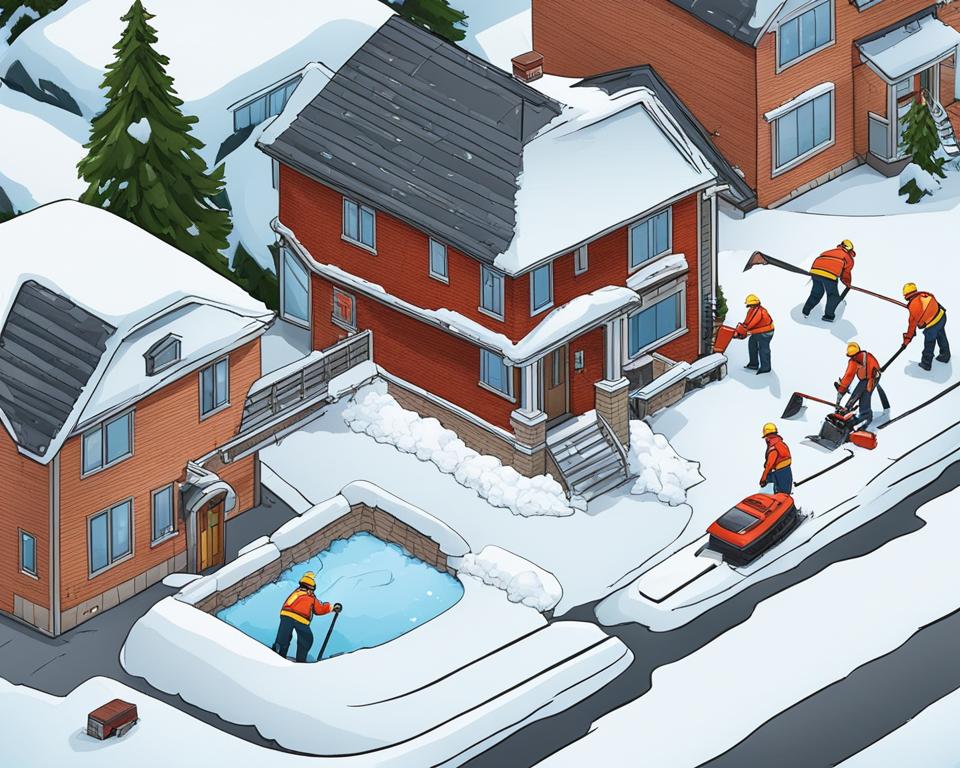Snow removal from roofs is crucial to prevent damage and ensure safety during winter weather. Homes built to code can typically withstand the weight of snow, but older roof structures may be at risk. It is recommended to remove snow from the roof when it reaches a depth of 12 inches or higher. Flat roofs are more prone to structural damage due to the accumulation of snow and ice. Signs of a roof under excessive snow load include sagging ceiling tiles, popping noises, and cracked walls. Ice dams should also be addressed as they can cause roof leaks. Removing the snow and addressing the root cause of the ice dams is essential.
Key Takeaways:
- Removing snow from roofs is crucial for preventing roof damage and ensuring safety.
- Homes built to code can typically withstand the weight of snow, but older structures may be at risk.
- Remove snow from the roof when it reaches a depth of 12 inches or higher.
- Flat roofs are more prone to structural damage from snow and ice accumulation.
- Signs of excessive snow load include sagging ceiling tiles, popping noises, and cracked walls.
Safe Snow Removal Techniques
When it comes to removing snow from your roof, it’s important to use safe and effective techniques to prevent damage and ensure your own safety. Here are some best practices for snow removal:
1. Rope Method:
The rope method involves tying a heavy object to one end of a rope and tossing it over the roof. By pulling the rope back and forth, you can dislodge the snow and safely remove it from the roof. This method is ideal for areas with lighter snowfall and can be done without stepping onto the roof.
2. Heating Cable:
Another option is to use a heating cable, which is an electrical device designed to melt snow and ice on the roof. The cable is installed along the roof edges and prevents the formation of ice dams. This method is particularly effective for preventing roof leaks caused by ice dams.
3. Roof Rake:
A roof rake with a rubber blade can be a useful tool for removing snow from the roof. It allows you to safely scrape the snow off the roof without damaging the shingles. Roof rakes are especially handy for sloped roofs where snow can easily slide off.
4. Non-Corrosive De-Icer Material:
Using a non-corrosive de-icer material can help melt ice and clear the roof. One way to do this is by filling pantyhose with the de-icer and placing it along the roof edge. As the de-icer melts, it will create a channel for the snow and ice to drain off the roof safely.
Remember to always prioritize your safety when removing snow from your roof. Use appropriate protective gear, such as gloves and goggles, and avoid using metal shovels that can damage the roof. By following these techniques, you can safely remove snow from your roof and prevent potential damage.
Hiring a Professional for Snow Removal
For homeowners who are not comfortable or physically unable to remove snow from their roofs, hiring a professional for the job is a smart choice. Professional snow removal companies have the expertise and equipment necessary to safely and efficiently remove snow from roofs. Their experience ensures that the snow removal process is done correctly, eliminating the risk of injury and minimizing any potential damage to the roof.
When hiring a professional for roof snow removal, homeowners can expect efficient and thorough service. These professionals have the knowledge to assess the roof for any potential damage and can address any underlying issues that may be contributing to the snow accumulation, such as inadequate insulation or ventilation. By addressing the root cause, they help prevent future snow buildup and potential damage to the roof.
Additionally, professional snow removal companies have the proper tools and equipment to get the job done safely and effectively. They are equipped with specialized snow removal tools like roof rakes and snow blowers, which allow for efficient snow removal without causing any harm to the roof or its structure. By relying on professionals, homeowners can have peace of mind knowing that their roofs are in good hands.
Benefits of Hiring a Professional for Roof Snow Removal:
- Expertise and experience in safely removing snow from roofs
- Ability to assess the roof for potential damage and address underlying issues
- Access to specialized snow removal tools and equipment
- Saving time and effort by entrusting the task to professionals
- Reducing the risk of injury and minimizing potential damage to the roof
In conclusion, hiring a professional for snow removal is the efficient and reliable way to ensure that snow is safely removed from the roof. Homeowners can benefit from the expertise, experience, and specialized tools that professional snow removal companies bring to the table. By entrusting the task to professionals, homeowners can protect their roofs and avoid the risks associated with DIY snow removal.

Snow Removal Safety Measures
When it comes to removing snow from roofs, safety should be the top priority. Taking the necessary precautions can help prevent accidents and injuries. Here are some snow removal safety measures to keep in mind:
Dress Appropriately
Wearing the right gear is essential when removing snow from the roof. Make sure to wear gloves to protect your hands from cold and sharp objects. Opt for warm boots with good traction to prevent slipping on icy surfaces. Additionally, wearing goggles can provide eye protection from snow and debris.
Use the Buddy System
Working alone on the roof can be risky, especially in snowy conditions. It is recommended to have a spotter present while removing snow. A spotter can help keep an eye out for any potential hazards and provide assistance if needed.
Avoid Metal Shovels
When clearing snow from the roof, it’s best to avoid using metal shovels. Metal shovels can damage the roof surface, leading to costly repairs. Instead, opt for a plastic or rubber-bladed shovel specifically designed for snow removal.
Be Mindful of Snow Disposal
When removing snow from the roof, it’s important to be mindful of where the snow is being dropped. Avoid piling the snow near walkways, entrances, or areas where it can cause damage or injury. Clear a safe path for the snow to fall, away from people and objects.
By following these snow removal safety measures, you can ensure a safer and more efficient snow removal process. Remember to prioritize your safety and take breaks when needed. If you’re unsure about removing snow from your roof, it’s always best to consult a professional who can handle the task safely and effectively.
Conclusion
Clearing snow from roofs is essential to prevent damage and ensure safety. While sloped roofs built to code can typically handle snow weight, older roof structures may be at risk. Flat roofs require extra attention due to snow and ice accumulation. To safely remove snow, there are several tools available for roof clearing. Ropes, heating cables, roof rakes, and non-corrosive de-icers are among the most effective options.
If homeowners are uncomfortable or unable to remove snow themselves, hiring a professional is strongly recommended. Professional snow removal companies have the expertise and equipment to safely and efficiently clear roofs. They can also assess the roof for any potential damage or issues. By hiring a professional, homeowners can ensure that the snow removal process is done correctly and eliminate the risk of injury.
When performing snow removal, safety measures should always be followed. Wearing appropriate gear, having a spotter present, and avoiding metal shovels are crucial. It’s also important to be mindful of where the snow is dropped, ensuring it doesn’t cause damage or injury. Lastly, avoid using salt on the roof, as it can lead to corrosion and costly repairs.
By taking these snow removal safety measures and using the right tools, homeowners can protect their roofs and prevent accidents or injuries. Therefore, it is important to prioritize snow removal to prevent roof damage and ensure a safe living environment during winter.
FAQ
How often should snow be removed from the roof?
Snow should be removed from the roof when it reaches a depth of 12 inches or higher.
What signs indicate that a roof is under excessive snow load?
Signs of a roof under excessive snow load include sagging ceiling tiles, popping noises, and cracked walls.
What should be done about ice dams on the roof?
Ice dams should be addressed promptly to prevent roof leaks. Removing the snow and addressing the root cause of the ice dams is essential.
What are some safe snow removal techniques for roofs?
Safe snow removal techniques include using ropes, heating cables, roof rakes, and non-corrosive de-icers.
When should a professional be hired for snow removal?
It is recommended to hire a professional for snow removal if homeowners are not comfortable or physically unable to do the job themselves.
What safety measures should be taken when removing snow from roofs?
Safety measures include wearing appropriate gear, having a spotter present, avoiding metal shovels, and being cautious of where the snow is dropped.
Can salt be used to remove snow from the roof?
No, salt should not be used on the roof as it can corrode materials and lead to costly repairs.


